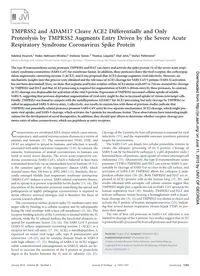
2014 TMPRSS2 and ADAM17 Cleave ACE2 Differentially and Only Proteolysis by TMPRSS2 Augments Entry Driven by the Severe A PDF
Preview 2014 TMPRSS2 and ADAM17 Cleave ACE2 Differentially and Only Proteolysis by TMPRSS2 Augments Entry Driven by the Severe A
TMPRSS2 and ADAM17 Cleave ACE2 Differentially and Only Proteolysis by TMPRSS2 Augments Entry Driven by the Severe Acute Respiratory Syndrome Coronavirus Spike Protein Adeline Heurich,a Heike Hofmann-Winkler,a Stefanie Gierer,a Thomas Liepold,b Olaf Jahn,b Stefan Pöhlmanna ‹Infection Biology Unit, German Primate Center, Göttingen, Germanya; Proteomics Group, Max Planck Institute of Experimental Medicine, Göttingen, Germanyb The type II transmembrane serine proteases TMPRSS2 and HAT can cleave and activate the spike protein (S) of the severe acute respi- ratory syndrome coronavirus (SARS-CoV) for membrane fusion. In addition, these proteases cleave the viral receptor, the carboxypep- tidase angiotensin-converting enzyme 2 (ACE2), and it was proposed that ACE2 cleavage augments viral infectivity. However, no mechanistic insights into this process were obtained and the relevance of ACE2 cleavage for SARS-CoV S protein (SARS-S) activation has not been determined. Here, we show that arginine and lysine residues within ACE2 amino acids 697 to 716 are essential for cleavage by TMPRSS2 and HAT and that ACE2 processing is required for augmentation of SARS-S-driven entry by these proteases. In contrast, ACE2 cleavage was dispensable for activation of the viral S protein. Expression of TMPRSS2 increased cellular uptake of soluble SARS-S, suggesting that protease-dependent augmentation of viral entry might be due to increased uptake of virions into target cells. Finally, TMPRSS2 was found to compete with the metalloprotease ADAM17 for ACE2 processing, but only cleavage by TMPRSS2 re- sulted in augmented SARS-S-driven entry. Collectively, our results in conjunction with those of previous studies indicate that TMPRSS2 and potentially related proteases promote SARS-CoV entry by two separate mechanisms: ACE2 cleavage, which might pro- mote viral uptake, and SARS-S cleavage, which activates the S protein for membrane fusion. These observations have interesting impli- cations for the development of novel therapeutics. In addition, they should spur efforts to determine whether receptor cleavage pro- motes entry of other coronaviruses, which use peptidases as entry receptors. C oronaviruses are enveloped RNA viruses which cause enteric, respiratory, and central nervous system diseases in a variety of animals and humans (1). The coronaviruses NL63, 229E, and OC43 are adapted to spread in humans, and infection is usually associated with mild respiratory symptoms (2–8). In contrast, the zoonotic transmission of animal coronaviruses to humans can result in novel, severe diseases. The severe acute respiratory syn- drome coronavirus (SARS-CoV), which is believed to have been transmitted from bats via an intermediate host to humans (9–11), is the causative agent of the respiratory disease SARS, which claimed more than 700 lives in 2002-2003 (12). Similarly, the re- cently emerged Middle East respiratory syndrome coronavirus (MERS-CoV) induces a severe, SARS-related respiratory disease, and its spread is at present responsible for 64 deaths (13, 14). The elucidation of the molecular processes underlying the spread and pathogenesis of highly pathogenic coronaviruses is required to devise effective antiviral strategies and is therefore the focus of current research efforts. The coronavirus surface protein spike (S) mediates entry into target cells by binding to a cellular receptor and by subsequently fusing the viral envelope with a host cell membrane (15, 16). The receptor binding activity of the S proteins is located within the S1 subunit, while the S2 subunit harbors the functional elements re- quired for membrane fusion (15, 16). The SARS-CoV S protein (SARS-S) utilizes angiotensin converting enzyme 2 (ACE2) as a receptor for host cell entry (17, 18). ACE2, a metallopeptidase, is expressed on major viral target cells, type II pneumocytes and enterocytes (19–22), and its catalytic domain binds to SARS-S with high affinity (17, 23). Binding of SARS-S to ACE2 triggers subtle conformational rearrangements in SARS-S, which are be- lieved to increase the sensitivity of the S protein to proteolytic digest at the border between the S1 and S2 subunits (24, 25). Cleavage of the S protein by host cell proteases is essential for viral infectivity (15), and the responsible enzymes constitute potential targets for intervention. The SARS-CoV can hijack two cellular proteolytic systems to ensure the adequate processing of its S protein. Cleavage of SARS-S can be facilitated by cathepsin L, a pH-dependent endo-/ lysosomal host cell protease, upon uptake of virions into target cell endosomes (25). Alternatively, the type II transmembrane serine proteases (TTSPs) TMPRSS2 and HAT can activate SARS-S, pre- sumably by cleavage of SARS-S at or close to the cell surface, and activation of SARS-S by TMPRSS2 allows for cathepsin L-inde- pendent cellular entry (26–28). Both TMPRSS2 and HAT are ex- pressed in ACE2-positive cells in the human lung (27, 29), and results obtained with surrogate cell culture systems suggest that TMPRSS2 might play a significant role in SARS-CoV spread in the human respiratory tract (30). Notably, TMPRSS2 and HAT also activate influenza viruses bearing a hemagglutinin with a mono- basic cleavage site (31, 32) and TMPRSS2 was shown to cleave and activate the F protein of human metapneumovirus (33), indicat- ing that several human respiratory viruses hijack TTSPs to pro- mote their spread. The role of host cell proteases in SARS-CoV infection is not limited to cleavage of the S protein: two studies suggest that ACE2 is proteolytically processed by host cell proteases and that process- Received 8 August 2013 Accepted 5 November 2013 Published ahead of print 13 November 2013 Address correspondence to Stefan Pöhlmann,
